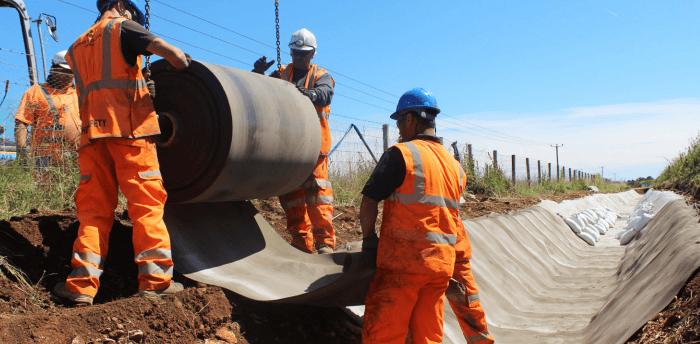Concrete Canvas vs. Traditional Shotcrete and Concrete for Pond and Culvert Lining: A Comparative Analysis
When it comes to lining ponds and culverts for wastewater management, erosion control, or water containment, engineers and contractors face a critical decision: which material offers the best balance of durability, cost, ease of installation, and environmental impact? Traditional solutions like shotcrete (spraycrete) and poured or precast concrete have long been the go-to choices, but innovative alternatives like Concrete Canvas (CC) are gaining traction.
CIVIL DESIGN
5/22/20256 min read


Concrete Canvas is a flexible, concrete-impregnated fabric that hardens upon hydration to form a thin, durable, waterproof, and fire-resistant concrete layer. Available in products like Concrete Canvas® (CC) for erosion control and CC Hydro™ (CCH) for containment applications, it combines a concrete-filled geotextile with a PVC backing for impermeability in some variants. It’s designed for rapid installation and is increasingly used for lining ponds, culverts, channels, and other water management structures.
In contrast, shotcrete (spraycrete) is a sprayed concrete mixture applied pneumatically to form a seamless, durable lining, while traditional concrete involves poured or precast rigid structures made from cement, aggregates, and water. Both have been widely used for decades but come with logistical and environmental challenges.
We’ll evaluate Concrete Canvas, shotcrete, and traditional concrete based on durability, cost, installation, environmental impact, maintenance, and suitability for ponds and culverts.
1. Durability
Concrete Canvas:
Concrete Canvas is certified by the British Board of Agrément (BBA) for a durability of up to 120 years, making it a long-lasting solution for erosion control and containment. Its flexible, fiber-reinforced concrete layer resists cracking under ground movement and is resistant to chemical degradation in wastewater environments. CC Hydro™, with its geomembrane backing, offers excellent impermeability for ponds. However, it may be less suited for high-impact or load-bearing applications compared to traditional concrete.Shotcrete:
Shotcrete forms a strong, monolithic layer that adheres well to various surfaces, offering good resistance to erosion and moderate chemical exposure. However, it’s prone to cracking under significant ground movement or freeze-thaw cycles, and its durability depends on proper application and reinforcement (e.g., steel mesh). Without protective sealants, corrosive wastewater can degrade shotcrete over time.Traditional Concrete:
Poured or precast concrete is highly durable, with a lifespan of 50–100 years when properly designed and maintained. Reinforced concrete resists physical damage and chemical corrosion, but it can develop cracks due to settlement, thermal expansion, or seismic activity. Specialized coatings are often needed to enhance resistance to wastewater’s acidic or alkaline conditions.
Winner: Traditional concrete offers superior durability for high-load or structurally demanding applications, but Concrete Canvas is highly competitive for ponds and culverts due to its flexibility and long certified lifespan.
2. Cost
Concrete Canvas:
While specific pricing varies, Concrete Canvas is generally cost-competitive due to lower installation costs. The material itself is more expensive than geotextiles ($1–$3 per square foot, depending on thickness and type), but reduced labor, equipment, and installation time make it cost-effective. For example, a project in Indonesia found traditional concrete financially unfeasible due to high logistics and labor costs, whereas CC was viable.Shotcrete:
Shotcrete costs typically range from $5–$10 per square foot, including materials and labor. Costs increase with reinforcement, surface preparation, and site access challenges. Rebound (material waste during spraying) can further elevate costs.Traditional Concrete:
Poured or precast concrete is the most expensive, ranging from $8–$15 per square foot or higher, driven by material costs, formwork, reinforcement, and skilled labor. Large-scale pond or culvert projects often face significant logistical expenses, especially in remote areas.
Winner: Concrete Canvas offers significant cost savings, particularly for projects with limited access or tight budgets, due to its streamlined installation process.
3. Installation
Concrete Canvas:
Concrete Canvas is delivered in rolls, cut to size with hand tools, and laid over the substrate, where it’s hydrated to harden. It can be installed up to 10 times faster than traditional concrete, often in days rather than weeks, with minimal training or heavy machinery required. For example, a 3,000 m² road sector project was completed in 12 days with CC, compared to over three months for shotcrete. Its flexibility allows it to conform to irregular pond or culvert shapes, and it can be installed in wet or humid conditions, unlike some coatings.Shotcrete:
Shotcrete requires specialized equipment (e.g., spray rigs) and skilled operators, increasing setup time and costs. Surface preparation, reinforcement placement, and curing (several days) add to the timeline. Rebound can create mess and environmental concerns, and site access limitations may necessitate road closures or heavy machinery, as noted in a UK road project where shotcrete was deemed impractical.Traditional Concrete:
Poured concrete involves extensive formwork, reinforcement, pouring, and curing, often taking weeks for large ponds or culverts. Precast concrete reduces on-site time but requires transport and precise placement. Both methods demand significant site preparation and heavy equipment, making them challenging in remote or confined areas, as seen in a hydroelectric project in Indonesia where poured concrete was ruled out.
Winner: Concrete Canvas is the clear leader for ease and speed of installation, especially in remote or complex sites.
4. Environmental Impact
Concrete Canvas:
Concrete Canvas uses less material than traditional concrete, reducing its carbon footprint. The company has also invested in sustainability, such as a 1.1 MWp solar array at its factory to offset production emissions. CC’s surface supports organic growth, which can further reduce environmental impact over its 120-year lifespan. However, the PVC backing in CC Hydro™ is petroleum-based, posing disposal challenges.Shotcrete:
Shotcrete’s environmental impact stems from cement production, which generates significant CO2 (approximately 8% of global emissions). Rebound wastes material, and the need for heavy machinery increases energy use. However, shotcrete uses less material than poured concrete, slightly lowering its footprint.Traditional Concrete:
Traditional concrete has a high environmental cost due to cement production and transportation. Its long lifespan and potential for recycling (e.g., as aggregate) mitigate some impacts, but the energy-intensive process and large material volume make it less sustainable than CC.
Winner: Concrete Canvas has a lower environmental impact due to reduced material use and faster installation, though its PVC component requires careful disposal consideration.
5. Maintenance
Concrete Canvas:
Once hydrated and set, Concrete Canvas requires minimal maintenance due to its resistance to cracking, chemical degradation, and erosion. Its flexibility accommodates minor ground movement, reducing repair needs. Regular inspections ensure integrity, especially in high-wear areas like culverts with heavy debris flow.Shotcrete:
Shotcrete may develop cracks or surface degradation, particularly in corrosive wastewater environments or under freeze-thaw cycles. Repairs involve patching or reapplication, which can be disruptive and costly. Sealants can extend its lifespan but add to maintenance efforts.Traditional Concrete:
Concrete requires periodic inspections for cracks, spalling, or reinforcement corrosion. Repairs are complex, often involving crack sealing or partial replacement, and can be expensive for large structures. Protective coatings reduce maintenance but increase initial costs.
Winner: Concrete Canvas typically requires the least maintenance due to its flexibility and resistance to environmental stressors.
6. Suitability for Ponds and Culverts
Concrete Canvas:
Concrete Canvas is highly suitable for lining ponds and culverts, particularly for erosion control and containment. CC Hydro™ is designed for wastewater ponds, offering impermeability and chemical resistance, as demonstrated in a 2017 UK refinery tank lining project. CC’s ability to conform to irregular shapes makes it ideal for culverts, and its rapid installation suits time-sensitive projects. However, it may not provide the structural strength needed for heavy-load culverts.Shotcrete:
Shotcrete is effective for culverts requiring moderate structural support and erosion resistance. It adheres well to existing surfaces, making it suitable for remediation, but its impermeability may require additional liners for wastewater ponds. Rebound and site access issues can limit its practicality, as seen in a Greek bund lining project where shotcrete was rejected.Traditional Concrete:
Traditional concrete excels in large, structurally demanding ponds or culverts, particularly in unstable soils or high-traffic areas. Its rigidity ensures stability, but it’s less adaptable to irregular shapes and requires extensive preparation, making it less practical for smaller or remote projects.
Winner: Concrete Canvas is often the best choice for ponds and culverts due to its versatility, impermeability (with CC Hydro™), and ease of installation, though traditional concrete is preferred for heavy-duty structural needs.
Which Should You Choose?
Choose Concrete Canvas for ponds and culverts where rapid installation, cost savings, and flexibility are priorities. It’s ideal for wastewater containment, erosion control, and projects with limited site access or irregular shapes. CC Hydro™ is particularly suited for impermeable pond linings.
Choose Shotcrete for culvert remediation or projects requiring moderate structural support and adaptability, but where budget and site access allow for specialized equipment and labor. It’s a middle-ground option but less efficient than CC.
Choose Traditional Concrete for large-scale or structurally critical ponds and culverts, especially in high-load or unstable environments. It’s the most robust option but comes with higher costs and logistical challenges.
Concrete Canvas represents a revolutionary alternative to traditional shotcrete and concrete for lining ponds and culverts. Its rapid installation, cost-effectiveness, and lower environmental impact make it a compelling choice for modern water management projects, as highlighted in the Concrete Canvas Civil Brochure (https://www.concretecanvas.com/uploads/2019/11/cc-civil-brochure.pdf). While shotcrete offers versatility and traditional concrete provides unmatched strength, both are hindered by longer installation times, higher costs, and environmental drawbacks. For most pond and culvert applications, particularly those prioritizing speed, flexibility, and sustainability, Concrete Canvas is a game-changer.
For project-specific guidance, consult with a civil engineer or contact Concrete Canvas for tailored recommendations to ensure compliance with local regulations and optimal performance.
